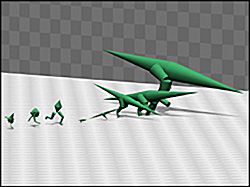T. rex could outrun a human athlete
T. rex could outrun a human athlete
mongabay.com
August 22, 2007
T. rex could reach speeds of up to 18mph, according to new supercomputer simulations that are believed to be the most accurate projections ever produced.
However T. rex could be easily outrun by the smaller Compsognathus, which could run at speeds of almost 40mph — about 5mph faster than the computer’s estimate for the fastest living animal on two legs, the ostrich.
The researchers — led by biomechanics expert Bill Sellers and palaeontologist Phil Manning from the University of Manchester — say the work is the first to estimate speeds based on data relating directly to each dinosaur.
“Previous research has relied on data from extant bipedal models to provide clues as to how fast dinosaurs could run,” said Dr Sellers. “Such calculations can accurately predict the top speed of a six-tonne chicken but dinosaurs are not built like chickens and nor do they run like them.

|
“Our research involved feeding information about the skeletal and muscular structure of the dinosaurs directly into the supercomputer so it could work out how the animals were best able to move.”
“The figures we have produced are the best estimate to date as to how fast these prehistoric animals could run,” said collaborator Dr Manning, a lecturer in palaeontology in the School of Earth, Atmospheric and Environmental Sciences.
“Since the movie Jurassic Park, scientists have questioned the speed of these dinosaurs and some have wondered whether Tyrannosaurus could have run at all.
“Our research, which used the minimum leg-muscle mass T. rex required for movement, suggests that while not incredibly fast, this carnivore was certainly capable of running and would have little difficulty in chasing down footballer David Beckham for instance.”
The research is published in this week’s issue of Proceedings of the Royal Society B.
| Organism | Weight | Metres/sec | Km/hour | Miles/hour |
| Human | 71kg | 7.9 | 28.4 | 17.7 |
| Emu | 27.2kg 13.3 | 47.9 | 29.8 | |
| Ostrich | 65.3kg 15.4 | 55.4 | 34.5 | |
| Compsognathus 3kg | 17.8 | 64.1 | 39.8 | |
| Velociraptor | 20kg | 10.8 | 38.9 | 24.2 |
| Dilophosaurus 430kg | 10.5 | 37.8 | 23.5 | |
| Allosaurus | 1.4 tonnes 9.4 | 33.8 | 21.0 | |
| Tyrannosaurus 6 tonnes 8.0 | 28.8 | 17.9 |
This article is based on a news release from the University of Manchester.














